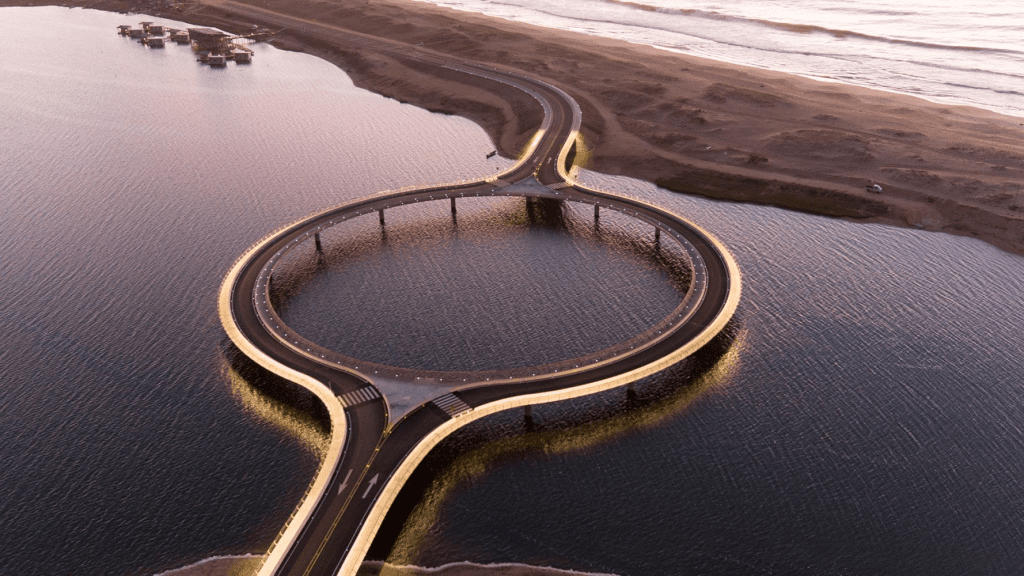Bridges have long been essential for connecting cities, regions, and countries. Typically, they are constructed with straightforward designs that prioritize functionality and efficiency. However, in a surprising twist, architect Rafael Viñoly from Uruguay introduced a groundbreaking approach to bridge design—by constructing a circular bridge. Completed in 2016 and stretching across Laguna Garzón, this structure isn’t just about aesthetics; it serves a deeper purpose that sets it apart from traditional bridges. But why exactly was such an unusual design chosen, and what benefits does it offer?

The idea of a circular bridge may seem strange at first. After all, most bridges are linear, designed to offer the shortest distance between two points. However, the circular bridge at Laguna Garzón was intentionally crafted with a distinct purpose in mind: to slow down traffic and encourage drivers to take in the stunning natural surroundings.
Instead of rushing across a conventional straight bridge, drivers are forced to reduce their speed while navigating the curved path. This not only makes the crossing safer but also offers travelers a unique opportunity to appreciate the breathtaking views of the lagoon. Essentially, the circular bridge transforms a routine commute into a moment of reflection and enjoyment.
The design of the circular bridge wasn’t a quick decision. It took years of debate and planning before it was finalized. Measuring 51.5 meters in radius, the bridge features two straight entrance sections that span 46 meters each. This layout creates two lanes of traffic, allowing vehicles to smoothly travel across the lagoon while keeping the center of the structure open as a functional waterway.
The middle of the bridge also doubles as a lagoon, where visitors can fish, walk, or simply enjoy the surroundings. The architect, Rafael Viñoly, envisioned the bridge as more than just a road; he saw it as a pedestrian-friendly space and a place where nature and human activity could coexist in harmony. As Viñoly explained, “The concept was to turn a vehicular crossing into an event, encouraging people to slow down and enjoy panoramic views of the beautiful landscape.”
Before the construction of the bridge, crossing the lagoon between the departments of Rocha and Maldonado was an arduous task. Drivers had to load their cars onto a raft and be ferried across the water, a process that was time-consuming and inefficient. With the completion of the Laguna Garzón Bridge, approximately 1,000 vehicles now cross the lagoon each day, greatly improving commuting times and convenience.
This bridge symbolizes more than just an engineering feat. It represents Uruguay’s broader ambitions to promote sustainability and eco-tourism. The government viewed the project as an opportunity to develop the relatively untouched coastline of Rocha, making it more accessible to locals and tourists alike. In 2015, Uruguay welcomed a record-breaking 2.9 million tourists, and the construction of the bridge is part of the country’s efforts to further boost tourism and economic growth.
While circular bridges are not unheard of, they are generally used in contexts other than road traffic, such as pedestrian crossings or decorative purposes. The Laguna Garzón Bridge stands out because it blends the aesthetic appeal of a circular structure with practical road traffic functionality.

The circular design forces vehicles to decelerate, a key safety feature. In contrast to traditional straight bridges, which often encourage speeding, the circular layout enhances traffic control, ensuring that drivers proceed cautiously around the curve. This is especially useful in a scenic area like Laguna Garzón, where the goal is to protect both the natural environment and the people who visit it.
One of the driving forces behind the construction of the circular bridge was the potential to boost tourism in Rocha. Before the bridge’s construction, the area was relatively isolated due to the limited accessibility. With the new structure in place, more visitors can easily explore Rocha’s pristine beaches, increasing foot traffic to local businesses and contributing to the region’s economic development.
Additionally, the bridge was designed with sustainability in mind. Private enterprises invested $10 million of the $11 million total project cost, with the aim of creating a structure that harmonizes with its environment. The bridge’s circular design encourages appreciation of the lagoon, promoting eco-friendly tourism that highlights the beauty of the region while minimizing its environmental impact.

The Laguna Garzón Bridge is more than just a crossing point—it’s a symbol of how architecture can enhance both form and function. Its circular shape not only adds a unique visual appeal but also serves a crucial function in controlling traffic flow and promoting safety. By transforming a standard commute into an experience of reflection and natural beauty, this bridge has achieved a remarkable balance between aesthetics and efficiency.
Through careful planning, Uruguay has demonstrated that infrastructure projects can be environmentally conscious and economically beneficial. The circular bridge is not only a feat of engineering but also a testament to how innovative design can change the way we interact with our environment.
The circular bridge in Uruguay isn’t just a road over water—it’s an invitation to slow down, enjoy the journey, and connect with nature. By blending functionality, safety, and beauty, the bridge offers a glimpse into the future of infrastructure, where design goes beyond mere utility to enrich the human experience. As more vehicles and tourists cross Laguna Garzón each day, this circular marvel will continue to be a source of inspiration for engineers, architects, and travelers alike.


